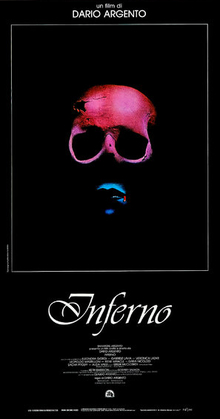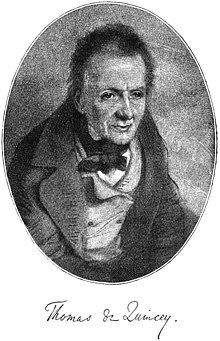
Charles Pierre Baudelaire was a French poet who also worked as an essayist, art critic and translator. His poems are described as exhibiting mastery of rhyme and rhythm, containing an exoticism inherited from Romantics, and are based on observations of real life.
Levana is an ancient Roman goddess involved in rituals pertaining to childbirth. Augustine says that dea Levana is invoked when the child is lifted de terra, from the earth or ground. Her function may be paralleled by the Greek Artemis Orthia, if interpreted as the Artemis who lifts or raises children.

Thomas Penson De Quincey was an English writer, essayist, and literary critic, best known for his Confessions of an English Opium-Eater (1821). Many scholars suggest that in publishing this work De Quincey inaugurated the tradition of addiction literature in the West.

Suspiria is a 1977 Italian supernatural horror film directed by Dario Argento, who co-wrote the screenplay with Daria Nicolodi, partially based on Thomas De Quincey's 1845 essay Suspiria de Profundis. The film stars Jessica Harper as an American ballet student who transfers to a prestigious dance academy but realizes, after a series of brutal murders, that the academy is a front for a supernatural conspiracy. It also features Stefania Casini, Flavio Bucci, Miguel Bosé, Alida Valli, Udo Kier, and Joan Bennett, in her final film role.

Les Paradis Artificiels is a book by French poet Charles Baudelaire, first published in 1860, about the state of being under the influence of opium and hashish. Baudelaire describes the effects of the drugs and discusses the way in which they could theoretically aid mankind in reaching an "ideal" world. The text was influenced by Thomas De Quincey's Confessions of an English Opium-Eater and Suspiria de Profundis.

Confessions of an English Opium-Eater (1821) is an autobiographical account written by Thomas De Quincey, about his laudanum addiction and its effect on his life. The Confessions was "the first major work De Quincey published and the one that won him fame almost overnight".
De profundis refers to Psalm 130, traditionally known as the De profundis from its opening words in Latin.

Our Lady of Darkness (1977) is an urban fantasy novel by American author Fritz Leiber. The novel is distinguished for three elements: the heavily autobiographical elements in the story, the use of Jungian psychology that informs the narrative, and its detailed description of "Megapolisomancy", a fictional occult science. It was originally published in shorter form as "The Pale Brown Thing".

Inferno is a 1980 Italian supernatural horror film written and directed by Dario Argento, and starring Irene Miracle, Leigh McCloskey, Eleonora Giorgi, Daria Nicolodi and Alida Valli. The plot follows a young man's investigation into the disappearance of his sister, who had been living in a New York City apartment building that also served as a home for a powerful, centuries-old witch. The cinematography was by Romano Albani, and Keith Emerson composed the film's musical score.
Negus is a drink made of wine, often port, mixed with hot water, oranges or lemons, spices and sugar.

The Three Mothers is a trilogy of supernatural horror films by Italian filmmaker Dario Argento. It consists of Suspiria, Inferno, and Mother of Tears. Each film deals with one of the titular "Mothers", a triumvirate of ancient witches whose powerful magic allows them to manipulate world events on a global scale, killing anyone who discover their whereabouts, and who are determined to rule the world.
Suspiria is a 1977 Italian horror film.

Mother of Tears is a 2007 supernatural horror film written and directed by Dario Argento, and starring Asia Argento, Daria Nicolodi, Moran Atias, Udo Kier and Coralina Cataldi-Tassoni. The film has also been billed in English-speaking media as Mater Lachrymarum, The Third Mother and Mother of Tears: The Third Mother.
Joel Black is a Professor of Comparative Literature at the University of Georgia in Athens, Georgia. Black has written extensively on subfields of literature and film studies areas such as romanticism, postmodernism, philosophy and history of science, and cultural studies. He is the author of The Aesthetics of Murder: A Study in Romantic Literature and Contemporary Culture (1991) and The Reality Effect: Film Culture and the Graphic Imperative (2002).
Robert J. H. Morrison is a Canadian author, editor, and academic. He is British Academy Global Professor at Bath Spa University and Queen's National Scholar at Queen's University, Kingston, Ontario. A scholar of late eighteenth- and nineteenth-century literature and culture, he is particularly interested in the Regency years (1811–1820), Blackwood's Edinburgh Magazine, Jane Austen, and Thomas De Quincey.
The English Mail-Coach is an essay by the English author Thomas De Quincey. A "three-part masterpiece" and "one of his most magnificent works," it first appeared in 1849 in Blackwood's Edinburgh Magazine, in the October and December issues.
Opium and Romanticism are well-connected subjects, as readers of Romantic poetry often come into contact with literary criticisms about the influence of opium on its works. The idea that opium has had a direct effect on works of romantic poetry is still under debate; however, the literary criticism that has emerged throughout the years suggests very compelling ideas about opium and its impact on Romantic texts. Usually these criticisms tend to focus on poets such as Samuel Taylor Coleridge, Thomas De Quincey and George Crabbe.
Nikos Fokas was a Greek poet, essayist and translator.
Autobiographic Sketches, sometimes referred to as the Autobiography of Thomas De Quincey, is a work first published in 1853.

This is a bibliography of works by Thomas De Quincey, a romantic English writer. Chiefly remembered today for his Confessions of an English Opium-Eater (1821), De Quincey's oeuvre includes literary criticism, poetry, and a large selection of reviews, translations and journalism. His private correspondence and diary have also been published.










